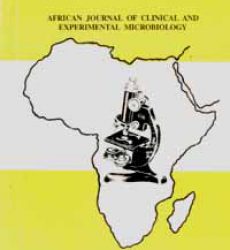Cytomegalovirus co-infection with HIV in children and adolescents on antiretroviral therapy in Abuja, Nigeria
1*Okechukwu, A. A., and 2Thairu, Y.
1Deparment of Paediatrics, University of Abuja Teaching Hospital, Gwagwalada, Abuja, Nigeria
2Department of Microbiology, University of Abuja Teaching Hospital, Gwagwalada, Abuja, Nigeria
Correspondence to: nebokest@yahoo.com; +2348036719906
Abstract:
Background: Cytomegalovirus (CMV) co-infection with human immunodeficiency virus (HIV) is known to accelerate HIV disease progression. It has the potential of being a killer disease or a silent lifetime companion in HIV patients. There is dearth of information on CMV prevalence among HIV infected children and adolescents in our environment. We therefore conducted this study to determine its sero-prevalence, and risk factors for co-infection among HIV infected children and adolescents on highly active antiretroviral therapy (HAART) in our center.
Method: A descriptive cross sectional study of HIV-infected children and adolescents aged 2 months to 18 years on HAART was conducted over a 6 month period between October 2017 and March 2018 in our health facility. Blood samples of subjects were screened for CMV IgM using commercial test kits. Biodata of subjects, CD4 cell count, and viral load were collected into a designed proforma, and statistical analysis was done with SPSS version 22.0.
Result: A total of 161 HIV-infected children and adolescents were recruited, 103 (64.0%) were males, 83 (51.6%) were between the ages of 5 and <10 years, 113 (70.2%) were from lower socio-economic class, and 138 (85.7%) were on 1st line HAART. Of the 17 (10.6%) subjects positive for CMV IgM, 3 (17.6%) were less than 5 years old, 11 (64.7%) were between the ages of 5-10 years, and none was older than 15 years. Univariate analysis showed significant differences in the mean age, weight, length/height, and systolic blood pressure between CMV IgM positive and negative patients (p<0.05), but no significant difference in gender, socioeconomic class, types of antiretroviral drugs, CD4 cell count, and viral load (p>0.05). Multivariate analysis however did not show any significant difference in age, weight, length/height, and systolic blood pressure. Conclusion: The prevalence of active CMV infections among HIV infected children and adolescents on HAART in our centre is high. Low CD4 cell count and high viral load were not associated with active CMV disease, and no risk factor for co-infection was also identified. Identifying those with primary/active infection will be necessary for possible treatment with anti-herpes drugs before development of reactivated CMV disease.
Keywords: CMV, HIV, co-infection, anti-retroviral, children, adolescents
Received June 27, 2019; Revised October 10, 2019; Accepted October 12, 2019
Copyright 2020 AJCEM Open Access. This article is licensed and distributed under the terms of the Creative Commons Attrition 4.0 International License (http://creativecommmons.org/licenses/by/4.0), which permits unrestricted use, distribution and reproduction in any medium, provided credit is given to the original author(s) and the source.
Co-infection par le cytomégalovirus et le VIH chez des enfants et des adolescents sous traitement antirétroviral à Abuja, au Nigéria
1*Okechukwu, A. A., et 2Thairu, Y.
1Département de pédiatrie, Hôpital universitaire de Abuja, Gwagwalada, Abuja, Nigéria 2Département de microbiologie, hôpital universitaire de Abuja, Gwagwalada, Abuja, Nigéria Correspondance à: nebokest@yahoo.com; +2348036719906
Abstrait:
Contexte: On sait que la co-infection par le cytomégalovirus (CMV) et le virus de l’immunodéficience humaine (VIH) accélère la progression de la maladie. Il a le potentiel d’être une maladie mortelle ou un compagnon
silencieux à vie chez les patients VIH. Il existe peu d’informations sur la prévalence du CMV chez les enfants et les adolescents infectés par le VIH dans notre environnement. Nous avons donc mené cette étude pour déterminer sa séroprévalence et les facteurs de risque de co-infection chez les enfants et les adolescents infectés par le VIH sous traitement antirétroviral hautement actif (HAART) dans notre centre. Méthode: Une étude transversale descriptive des enfants et adolescents infectés par le VIH et âgés de 2 mois à 18 ans sous multithérapie a été menée sur une période de 6 mois entre octobre 2017 et mars 2018 dans notre établissement de santé. Des échantillons de sang de sujets ont été testés pour l’IgM de CMV en utilisant des kits de test commerciaux. Les données biologiques des sujets, le nombre de cellules CD4 et la charge virale ont été recueillis dans un formulaire conçu à cet effet et une analyse statistique a été réalisée avec SPSS version 22.0. Résultat: 161 enfants et adolescents infectés par le VIH ont été recrutés, dont 103 (64,0%) étaient des hommes, 83 (51,6%) étaient âgés de 5 à moins de 10 ans, 113 (70,2%) étaient issus de milieux socio-économiques inférieurs. et 138 (85,7%) suivaient la multithérapie de première ligne. Sur les 17 (10,6%) sujets positifs pour l’IgM du CMV, 3 (17,6%) avaient moins de 5 ans, 11 (64,7%) étaient âgés de 5 à 10 ans et aucun n’avait plus de 15 ans. Une analyse univariée a montré des différences significatives dans l’âge moyen, le poids, la taille / taille et la pression artérielle systolique entre les patients positifs et négatifs pour IgM anti-CMV (p<0,05), mais aucune différence significative entre le sexe, la classe socio-économique, les types de médicaments antirétroviraux et les cellules CD4 nombre et charge virale (p>0,05). L’analyse multivariée n’a cependant montré aucune différence significative d’âge, de poids, de taille / taille et de pression artérielle systolique. Conclusion: La prévalence des infections à CMV actives chez les enfants et les adolescents infectés par le VIH sous HAART dans notre centre est élevée. Un faible nombre de cellules CD4 et une charge virale élevée n’étaient pas associés à la maladie à CMV active et aucun facteur de risque de co-infection n’a également été identifié. Identifier les personnes présentant une infection primaire / active sera nécessaire pour un traitement éventuel avec des médicaments anti-herpès avant le développement d’une maladie à CMV réactivée.
Mots-clés: CMV, HIV, co-infection, anti-rétroviral, Enfants, les adolescents
CMV and HIV co-infection in children Afr. J. Clin. Exper. Microbiol. 2020; 21 (1): 36 – 44
Download full journal in PDF below

